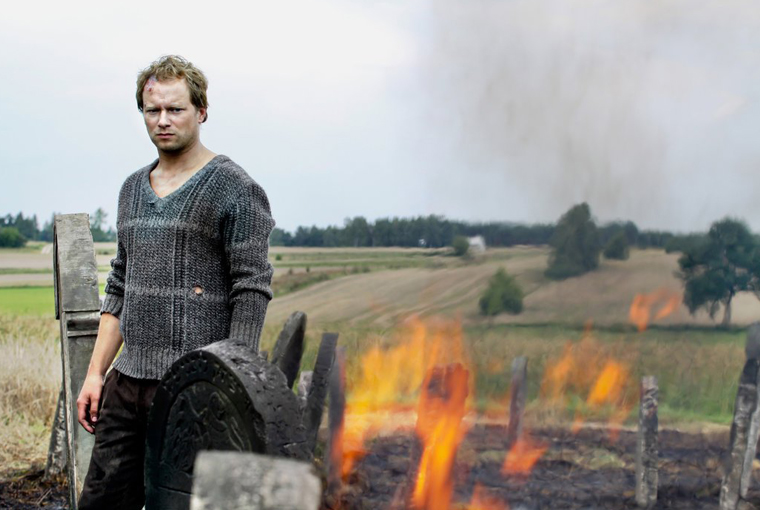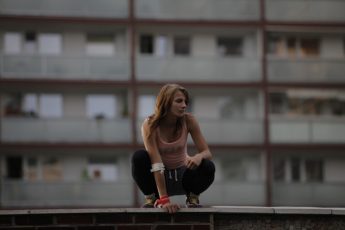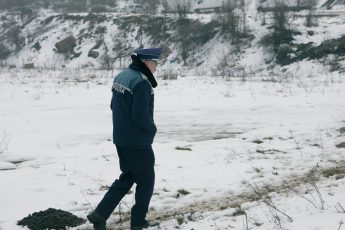Poles and the Holocaust
Wladyslaw Pasikowski’s Aftermath (Pokłosie, 2012)
Vol. 42 (June 2014) by Moritz Pfeifer
Every couple of decades or so, a book shows up that changes the way we think about history. School children who were educated with Howard Zinn’s A People’s History of the United States probably grew up having a more critical opinion about the merits of American rulership than their parents. So too, will Polish children most likely have an alternate view on their country’s role as a victim during the Second World War if they were instructed by Jan T. Gross’ Neighbors.
Neighbors was published in 2000 and gives a detailed account of the Jedwabne pogrom of July 1941, in which the non-Jewish inhabitants of the Polish village Jedwabne killed at least 340 Jews. The book provoked aggressive ideological as well as serious academic debates on the question of who is accountable for this massacre. On the one hand, there are those who insist on the story that the Nazis gave the orders and that they should ultimately be considered responsible for the killings. The other group, supported by Gross and others, argue that, since the pogrom was executed by the inhabitants of the town without coercion, the Poles have to be held liable for it. Although the broader historical question of the “ultimate cause” for the holocaust – sometimes also referred to as the intentionalism (it was a plan from above) vs. functionalism (it was a plan from below) debate – will probably never be resolved, Gross’ book demystifies the official ideology that the Poles were passive witnesses to the persecution and systematic eradication of its Jewish population. They were not only co-victims but often collaborators.
It is perhaps too early to conclusively measure the impact of this debate. Nevertheless, a considerable number of recent films have, for the first time in the history of Polish cinema, explicitly treated the subject of Gross’ book. Films like It Looks Pretty from a Distance (2011), Aftermath (2012), Secret (2012), and Ida (2013) all have Polish responsibility for World War II as a subject. However, they also all take place much later. They deal with the problem of dealing with the past instead of directly depicting it. It Looks Pretty from a Distance (2011) is an allegorical film about a man whose house is taken over by his neighbors after he leaves for a while. While it is in no way obvious that this film is really about Jedwabne-type incidents, the Sasnals explained in an interview they gave in 2011 that the film “is a metaphor of a plot from the past. This is what happened in Poland when people with Jewish neighbors took Jewish property! […] The story come from a book by Jan T. Gross.”
The other three films blend the past and the present less metaphorically. They compare the fate of those who try to look for the truth in the present with that of the victims of the past. They deal with history by showing people dealing with history. On the one hand, this narrative technique may seem more adequate. Poland’s problem is not a lack of knowledge about what happened. Most people knew what Gross proved in his book, although not with the same facts and details. Accepting these facts though, has contemporary, not historical relevance. One the other hand, it is rather regrettable that two of the films incoherently associate the virtue of finding out the truth about the past with the virtue of being Jewish. Accepting the facts should be a Polish issue, not a Jewish one. Yet in Ida and Secret, the main characters are Jewish. Only Aftermath chooses Polish fact finders. However, and here Aftermath is not an exception, all three films also seem to conflate the social stigma experienced by those trying to deal with the past with that of Jewish suffering. This latter aspect makes the films all the more problematic for, provided that the Poles should at least in theory deal with the past, making films about how this very process turns them into martyrs paradoxically keeps the myth of Poland as a victim alive.
Of the three films discussed here, Wladyslaw Pasikowski’s Aftermath most bluntly juxtaposes the process of dealing with the past with that of the Jews of Jedwabne. Two brothers, Józef (Maciej Stuhr) and Franciszek Kalina (Ireneusz Czop), try to uncover the past of the murdered Jewish citizens of their town in the 1990s shortly before the Neighbors debate started to take place. They uncover gravestones in a field and start digging up maps which reveal that their own and much of their neighbor’s property belonged to the families whose names are written on the gravestones. As they make their findings public, their fellow villagers try everything to keep the story quiet. History repeats itself. The brothers successively go through much of what their Jewish neighbors must have went though 70 years earlier. They no longer have access to the same services, are beaten, and later their farm is burned. Lastly, one of the brothers is crucified.
How strange! The film encourages the thought that the Jews, like the two brothers, suffered for some greater cause like truth, their belief or whatnot. But martyrdom, aside from being a deeply Catholic concept, is also a dubious factual explanation for the Holocaust. It suggests that there was an active provocation at its outset (like anti-Catholicism or religious supremacism) and thereby avoids finding motives, other than reactive ones, on the side of the aggressors. This would credit the film with actually being about Jewish-Polish relations during WWII. Which it is not. It really only makes quasi-biblical heroes out of Poles who deal with their past. ‘Poor Poland’, one is left to say, ‘what have the Jews done to you, that you have to go through so much suffering?’
Although Ida and Secret are much more subtle in every way, they follow Aftermath in associating sacrifice with finding out the truth. In Secret, truth-seeking Karolina is attacked by a war criminal from whom she is trying to get a confession. Although this film takes place in contemporary Poland, here too the victim gets punished and somehow redefined as the guilty party for wanting to find out the truth. In Ida, two women look for the fate of their ancestors in the 1960s. Anna (Agata Trzebuchowska) is a young nun, but was actually born Ida Lebenstein – her Jewish family, as she is to find out, had been killed by their neighbors in a forest near their farm. She unravels the past together with her Aunt Wanda (Agata Kulesza), who finds out that her son was killed by one of the neighbors. Towards the end of the film, Wanda commits suicide. Although it is unclear why she kills herself – grief, survivor’s guilt, sacrifice – the suggestion that truth kills lies quite near. Like in Aftermath, one of the two main characters gets sacrificed for finding out the truth. And even Anna, who is left to return alone to her convent, gets associated with a similar type of martyrly resignation. There is no place in this world for those who know what happened; so better speak to God. Interestingly, like in Aftermath these self-sacrificial gestures are portrayed via Catholic iconography. In Aftermath it is the crucifixion, in Ida the nunnery. Again, the quest for the past turns into a religious mission.
It is obvious that films which suggest that knowledge about Polish participation in the Holocaust is a matter of life and death, take considerable risks in making such films. Indeed, Aftermath provoked outrage in Polish conservative and nationalist journals1, and even the more neutral and artsy Ida earned some attacks2. The Western press was less convinced by its aesthetics. Many critics thought it inadequate that Pasikowski stole from the horror-film genre to deal with his subject, but nevertheless appreciated Aftermath’s good will, possibly also because of the fuss it provoked in the right-wing media at home. Ida, on the other hand, got almost unanimous praise. The New York Times critic O. A. Scott called it “one of the finest European films” and gave it five out of five stars. David Denby of the New Yorker called it a “masterpiece.” For both films, critics associated “the excavation of truth” (O.A. Scott) as an essential part of the films’ merit.
And yet we have seen that these films are not really concerned with excavating the past at all. To a large extent, they are self-referential, since they are, of course, not only about people dealing with the past but also made by people who do the same. It would be speculative to conclude from this that the same kind of worship for self-sacrificial truth-finding present in the films is also happening outside of them. Nevertheless, it is rather interesting to observe how these films, instead of inciting discussions about what happened, prompt politicians and media to laud the “brave[ry]” (Alexander Yanakiev for Fipresci.org on Ida)3, “courage” (Bogdan Zdrojewski, Poland’s Culture Minister during the Warsaw premier), and “bold[ness]”4 (Chris Cabin on Ida for Slant Magazine) of the movies more than they focus on the past. The deed of saying the message is more important than the message itself. Jan T. Gross’ book is about the murder of 340 Jews by their Polish neighbor. A film about this has not yet been made.




Leave a Comment